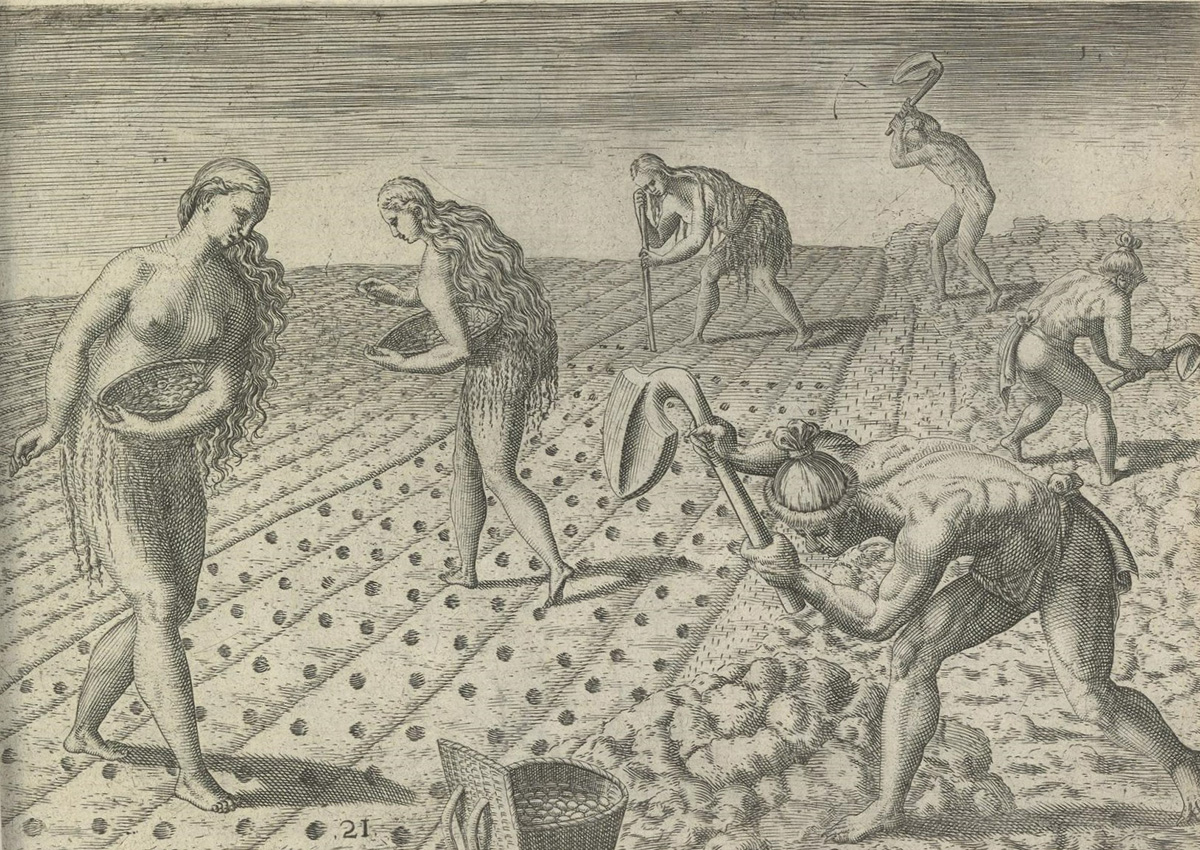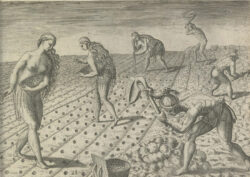Sagamité
Entry describes sagamité, a range of cornmeal-based soups, stews, and porridges with Native American origins that became a common component of French colonial cuisine.

Library of Congress
Indigenous people farming as depicted in "Brevis narratio eorvm qvae in Florida Americae provincia Gallis," 1591.
Sagamité refers to a broad range of cornmeal-based soups, stews, and porridges with Native American associations and origins. It is also sometimes used in the language of Louisiana French to refer to hominy—kernels of dried field corn boiled with wood ashes or some other alkaline source of calcium hydroxide, then either ground into meal or rehydrated and consumed whole. In 1886, Jean Andre Cuoq proposed that sagamité was a French transliteration of kijagamite, an Algonquin expression for “hot water.” A decade later, Reuben Gold Thwaites suggested sôgmôipi as the origin word, which he translated as “the repast of chiefs.” Both explanations seem plausible. At the time, boiled dried corn was a common element of a range of sagamité dishes, and it was served in ceremonial meals by Native leaders to Jesuits and other French people.
The French colonial idea of sagamité arrived in what is now Louisiana in the 1680s with Henri Joutel, who used the phrase to describe a variety of boiled corn dishes prepared by Caddos, Chickasaws, and others who helped to sustain the survivors of the La Salle expedition on their journey back to the Great Lakes via the Gulf Coast and the Mississippi River. By the middle of the eighteenth century, it had become common fare throughout French Louisiana as indicated by a generation of French colonial authors who referenced it in early descriptions of their regional cuisine. Antoine-Simone Le Page du Pratz raved about its virtues in L’Histoire de la Louisiane, as did the nun Marie Madeleine Hachard and the anonymous casquette girls of Mobile and New Orleans.
The wide array of sagamité as a category of corn-based dishes shows the diverse global influences that constitute Louisiana cuisine. French colonial cooks adopted Native American recipes throughout the colonial era, also adapting corn and other local ingredients for use in European-style preparations. African culinary expertise and ingredients provided further variation and improvisation, and sagamité—in different times and places—came to encompass almost anything made with corn that was eaten out of a bowl, either hot or cold. Substituting cornmeal for wheat in farine froide, for instance, resulted in a popular Creole variation of sagamité that foreshadowed the eventual emergence of “grits” as a staple of Southern cuisine. It could be sweetened with sugar or with maple or birch sap and larded with bear fat or palm oil. It could include venison, catfish, duck, alligator, beef, pork, fish, or fowl (or nothing). It could include beans and squash like the “succotash” associated with the eastern seaboard (or not). And, like “corn” itself— a colonial descriptor that reduced innumerable varieties of maize to a single word — “sagamité” ultimately referred to any kind of dried corn cooked in a pot.
